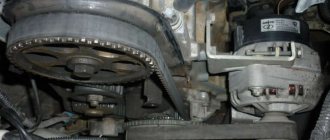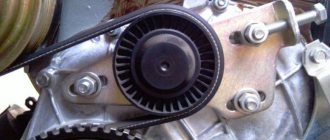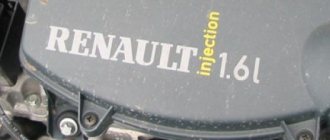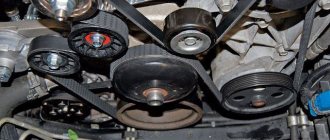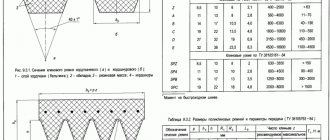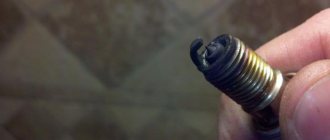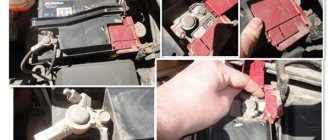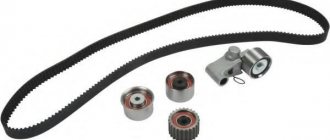Many motorists who do not have the slightest idea about the structure of a car have at least once heard about such a device as an alternator belt. This irreplaceable element can be with or without air conditioning. There are only two types of drive belts for cars: V-shaped and multi-V-shaped. Wedge-shaped RGs are considered traditional and are used mainly on older models of vehicles. It is allowed to use such belts in vehicles where the drive from the crankshaft is carried out to the unit itself. These straps have several subtypes and are distinguished by a special wedge-shaped profile. The most popular of them are gear ones, in which special teeth are located on the inner surface of the profile. The second type of drive belts are poly-V belts. Currently, such straps are installed everywhere. Poly V-belts are also commonly called multi-ribbed belts. The width of such belts is much greater, but the thickness is less. It is these characteristics of poly V-belts that make them more flexible.
The alternator belt is broken
On most cars, a broken alternator belt is indicated by a warning light with a battery icon on the instrument panel. It lights up because the battery stops charging. At the same time, the car does not “stall” for some time until the battery is completely drained. Finding this belt is not at all difficult; it is usually located in the most visible place under the hood. It is thanks to the generator belt that rotation is transmitted from the crankshaft to the generator shaft. A broken alternator belt can be caused by the following reasons:
- natural wear of the belt.
On average, the alternator belt must be replaced during mileage every 80-140 thousand km. However, it is necessary to take into account the manufacturers' recommendations. For example, on the Lada Vesta the belt is changed after every 15,000 km, and Toyota recommends replacing the alternator belt as necessary, checking its condition every 20 thousand km. Based on our experience, with working units (pulleys, generator, pump), the service life of the generator belt is about 100,000 km. Although, of course, a lot depends on who is the manufacturer of the belt itself... - More and more often, situations arise when the car owner changed the belt about 5 thousand km ago, and it broke. A thoughtless attempt to save money leads to a sad result. The ratio of the difference in price of a high-quality product to a low-quality product is not commensurate with the possible global consequences.
- malfunction of pulleys, shafts, tensioners.
If these components wear out/break, the alternator belt quickly fails. Almost all manufacturers recommend replacing the tensioner rollers when replacing the alternator belt. - insufficient or excessive belt tension.
Incorrect tension adjustment leads to the same consequences as in the case of unit failure. If the tension is insufficient, when the generator belt slips without having a strong enough adhesion to the working surface of the pulley, it overheats, loses elasticity and breaks. In case of excessive tension, the reinforcing fibers gradually stretch and break. A characteristic whistle can indicate that not everything is in order with the belt tension. This usually happens in wet weather.
Is it possible to continue driving after the belt breaks?
Many experts claim that you can continue driving if the alternator belt breaks without consequences for the car until the battery is completely discharged. However, they forget that more and more cars are appearing in which the generator and pump are driven on the same belt, and driving without coolant circulation can lead to engine overheating and very expensive repairs. And besides, modern batteries really don’t like deep discharge. Therefore, if you do not understand how your car works, it is better not to continue driving.
Broken alternator belt, what to do?
Let's consider several solutions:
- Replace the belt yourself if a spare is available and replace it yourself.
- If you have an understanding of what to do and the ability to work with your own hands, you can make a “temporary” belt (for example, from a trouser belt, women’s tights or a “men’s” tie, a piece of rope, etc.), but this is an extreme and temporary solution.
- Contact the comprehensive roadside assistance service "" and get a qualified service: either to replace the belt or to a service station.
V-ribbed belt
The route of the serpentine belt resembles a snake. Car manufacturers have designed the system so that one belt can drive several, if not all, of the accessories under the hood. One belt, regardless of its length, saves free space under the hood, since all additional units and pulleys are on the same level and do not need to be arranged in a pile or ledges. The ribbed side of the belt fits on grooved pulleys (each wedge-shaped), and the smooth back side of the belt often wraps around the water pump pulley and one or more idler pulleys. The tensioner pulley is needed to guide the belt, so the belt is wound around each accessory pulley for good power transfer. To maintain the correct tension for good energy transfer and at the same time avoid the need for constant adjustment, an automatic tension mechanism is often used.
There are an almost endless variety of tension mechanisms, but they all have a powerful coil spring inside.
The serpentine belt is capable of transmitting more power with less friction loss than traditional V-belts. A properly installed and automatically tensioned serpentine belt may not cause any problems for 4-5 years or 100,000 miles. Published: July 16, 2014
Timing belt broke
When the timing belt breaks, the car immediately stalls, because it synchronizes the operation of the engine’s crankshaft and camshaft. And when you try to start the car, a broken timing belt reveals itself by turning the engine too easily. Well, the most accurate way to determine a break is to look (of course, if you have: minimal experience, opportunity and tools; sometimes the belt is tightly closed with numerous plastic covers).
The following reasons can lead to a broken timing belt:
The timing belt breaks are caused by almost the same reasons as the alternator belt breaks:
- natural wear of the belt
, because The timing belt is one of the most important elements, the breakdown of which can lead to serious consequences. It is necessary to strictly adhere to the replacement deadlines, in accordance with the maintenance regulations of a particular vehicle. - defective belt or Chinese manufacturer.
- malfunction of rollers and tensioners, pumps
Broken timing belt, what are the consequences?
In modern engines, a broken timing belt in almost 95% of cases will lead to serious damage to the power unit, such as bending valves, breaking valve guides, breaking camshaft beds or puncturing a piston. Although, of course, there are designs with protection against timing belt breakage, and you will get by with “little loss” - just install the timing belt, without repairing components and assemblies.
Broken timing belt, what to do
Of course, if your car does not bend the valves, you can replace the belt yourself at the site of the breakdown (if you have a spare belt, the necessary tools and skills) or order from our comprehensive roadside assistance service “Avtodoctor” (if possible, our mechanics will help They will replace the timing belt for you on the spot). If the valve is bent, then your only option is to go to the nearest service station, where a lengthy and expensive repair awaits you. That is why we recommend that you undergo all maintenance on time and carefully monitor the condition of the car. Good luck on the roads! And we will always come to your aid if the need arises!
So, on the road the alternator belt broke. There is no doubt that this can happen to any driver. And, of course, this can happen when there is no thing in stock that is quite cheap and necessary at that moment. And it is unlikely that you will be able to find the belt far from the road. Naturally, it is also impossible to continue moving without it. As soon as you try to start driving, the engine will instantly overheat and the battery will be discharged.
What can you do if the generator drive belt breaks on the road?
First of all, you can use an old camera that may accidentally end up in your trunk. A ring should be cut out of it, which should have a width of about 20 mm. This ring can replace your alternator belt.
Next, a belt with a larger diameter can help you. From such a belt, cut a belt of the required diameter, and then tie it tightly with soft wire. This belt can serve you for quite a long time.
An ordinary clothesline can also help you out on the way. In order for it to be able to replace a broken generator drive belt, it is necessary to fold it three times according to its length. Then, leaving the ends free (about 10–20 cm), the rope should be intertwined. Next, the ends of the intertwined rope need to be passed through the loops, and the rope must be put on the pulleys.
The ends of the rope placed on the pulleys must be tied with a double knot. When putting on the rope, you must ensure that the resulting knot remains outside. There is no doubt that such a rope belt will not serve you for a long time, but you will be able to get to the nearest car service center or auto shop with its help.
Ordinary women's tights or stockings can also help you. You should tighten them as tightly as possible on the pulleys, and then they will easily withstand 70–90 km as a belt.
Many motorists will be interested to know why the alternator belt breaks. There may be several reasons that initiate a break; the owner will have to be careful to determine why exactly it breaks. Otherwise, no budget will support constant purchases of belts, and no one will want to change it every time.
What is the essence of the problem
That is, it opens and closes the intake and exhaust valves in time. And they, in turn, supply gasoline to the combustion chambers, and from there exhaust gases are removed through them.
Every passenger car driver must learn how to replace the engine timing belt - with a belt or chain at the right time.
After all, more than once they will have to replace both drives, not by themselves, but at a service station. And they should know how much it costs to replace a timing belt.
As motorists themselves say, you need to know the hardware well, especially the design of the timing belt.
Pulleys and Alignment
ATTENTION! A completely simple way to reduce fuel consumption has been found! Don't believe me? An auto mechanic with 15 years of experience also didn’t believe it until he tried it. And now he saves 35,000 rubles a year on gasoline!
So, why do belts break? Experts say one of the main reasons is that the pulley is installed crookedly. Lack of mutual alignment leads to the fact that the belt rotates incorrectly, touches various mechanisms with its sides, and quickly wears out.
It happens that the pulley on the power steering pump is placed backwards, incorrectly. Again, no alignment. The pulley is rearranged, the problem disappears.
It doesn’t hurt to always check another pulley – the crank pulley – for runout. Lack of mutual alignment can also occur due to a crooked crank shaft pulley.
To check the runout, just use a dial indicator.
A simple inspection of the pulleys is the first thing a caring car owner does. First of all, it is determined whether they are coaxial to each other. This is done like this: if the belt is pulled straight with a string, then the pulleys are in the same plane.
Attention. For V-belts, skew is allowed, but not more than 1 mm per 100 mm.
Alignment is an important thing. Checking it is the first step! It happens that not only the pulleys, but also the units themselves are crooked. For example, a non-original pump may be installed on a car. You check it and see that the difference in size from the hub to the base is very large.
It happens that pulleys come across prefabricated ones. That is, they are made from two halves using spot welding. When the belt is tensioned, the welding may fail and fall off. The tension will push the pulley halves apart, the belt will begin to fall into the resulting gap and tear.
The pulley may also not be original. That is, with a smaller diameter. In this case, a large load will appear on the generator, the belt will begin to slip, and accordingly, its sides will wear out.
It is, of course, better to replace such a pulley, but there are craftsmen who add washers, etc. This technique can achieve alignment, however, not always. You straighten one element, and then you notice that the power steering has gone out of plane or something else.
For reference:
- Pulleys from VAZs are not suitable for many cars due to the smaller diameter of the mounting hole;
- GAZ vehicles often have different planes of rotation, although the diameter may be the same.
Another reason is burrs on the pulley plane. They greatly wear out the rubber material of the belt and can create a step on the product, thereby shortening the service life and causing a break. In some cases, due to burrs, it is not possible to drive even a week with a new belt.
Burrs are nodules in the form of metal points that rise above the plane of the pulley. It is clear that this is not acceptable. You should go over them with a file, sand them, in a word. After this, the belt will serve its life, at least for at least 1 year (active operation of the machine).
Finally, the pulley itself may be too stiff. For example, this is observed on old domestic cars. You install new belts, but they are not designed for such metal - Soviet steel, stamped and non-separable design. It is better to replace such a pulley with a solid one made of some light alloy.
It is noteworthy that if the alignment is incorrect, the battery does not hold a charge for a long time, because the belt twists. That is, the gene no longer produces the required voltage, since it is not functioning correctly. All this can be determined by the battery, which quickly runs out.
So, the first reason why a belt can break is problems with the pulley and lack of alignment. Pulleys are often installed incorrectly; they may have differences in plane, burrs, etc. The pulleys themselves may not be original, prefabricated, or too hard.
Bearings have failed
The bearings that are installed in the generator can also cause a break. If they are not replaced in a timely manner, you will have to change not only them, but also the belt.
The bearings must rotate easily without a belt. If this is not the case, then there is a spell. There should also be no jamming or noise. Whatever malfunction of the bearing there is, it all lies inside, and without analysis you can’t determine anything meaningful.
If the gene bearings are faulty, the belt begins to whistle. It is obvious that bearings are structurally designed to soften the unintended process of friction of parts. If they are faulty, then they cannot cope with their functions, and as a result, friction increases.
Replacing generator bearings is common. Many experienced motorists decide to replace it themselves, saving money for repairs.
Failure or inconsistent operation of bearings is the second reason why belts on the generator break.
Belt
It is also obvious that the gene belt breaks due to excessive overtightening. The crank shaft damper bends due to this, because it is rubber and cannot withstand heavy loads. After which all the belts begin to tear, new and old.
The belt is often installed incorrectly, backwards. The upper pulling branch is launched under the roller. It is recommended to check the correct installation using the book.
In general, choosing the right belt is a whole science. Beginners often do not pay attention to this and do not take the matter with the necessary degree of seriousness. In fact, a lot depends on the quality of the belt.
Here are just a few points that give reason to reconsider your views:
- Low-grade belts stretch faster and, accordingly, soon begin to slip (as a result, the belt wears out faster and the charge is lost);
- A cheap, low-quality belt produces an unpleasant squeak during operation (the noise is especially loud when starting the engine).
When choosing a belt, you should always remember an important rule - pay attention not so much to price as to quality. Due to the intense competition in the markets these days, manufacturers are forced to come up with different ways to get ahead of their rivals. Increasing the price of a cheap product is one of the options to attract attention (after all, many still believe in the stereotype that if it’s more expensive, it means it’s good).
There are quite a lot of stories about a low-quality product supplied by a greedy owner. For example. One owner of Renault Megane 2 decided to save money. Instead of Kontiteg I installed a belt from a left company at a cheap price. In the end, everything resulted in a major overhaul of the engine, although such large costs could have been avoided by spending a little more when buying a belt.
And what happened: the low-quality gene belt did not last even 10 percent of its service life and broke. Its branches were wound around the tensioner roller, the other end got under the timing belt, which also came off. As a result, internal engine components flew off and valves were bent.
It is important to understand that the belt is an important thing. It bends around and drives several rollers and pulleys, which increases the load on the element. Therefore, its quality must be at its best; this is obvious logic.
The conteg is known for its reliability. Of course, they make belts in Germany, and there the quality is all right. Poly V-belts from this manufacturer have long won the love and respect of motorists around the world. According to official data, the service life of products from Kontiteg is only 10 percent lower than that of original belts.
Attention. According to the service book, the original belt must be replaced every 80 thousand km. If these are Kontiteg belts, then you can safely keep them on the generator for 70 thousand km of the car.
Jites is a very popular brand, however, the price of the products is somewhat overpriced. The service life of the products is the same as that of Kontiteg.
Daiko is also a good choice, although you can also buy Bosch belts. The main thing is not to run into a fake. If the name on the product is printed crookedly, the size of the symbols is increased or decreased, it is better to refuse the purchase. In addition, each represented manufacturer regularly introduces its consumers to new features that are difficult to counterfeit. You just need to be aware.
Well, the simple reason is that the belt does not fit. It is possible to install it, but then problems begin and it breaks. If it is longer, it will begin to sag; if it is short, then it will also not be possible to tighten it properly.
Tension
Incorrect tension causes the gene belt to break.
You can check the tension like this:
- arm yourself with a 50-centimeter metal ruler;
- check the belt for deflection.
The deflection of the belt transmitting the CM from the crank shaft to the crankshaft should be approximately 15 mm, taking into account the effect of a load of 10 kg per 1 cm of product length.
A narrow metal ruler is placed on top of the crank and generator pulleys. An impact is applied from above - a load of 10 kg/cm. Another ruler measures the deflection. There should be no discrepancies with the readings, otherwise the belt is not tensioned correctly.
Tension adjustment is carried out with keys, a pry bar and a ruler. The setup instructions assume the following:
- the fastening nuts located on the tension bar of the generating unit are loosened;
- The lower bolt securing the generator with the internal combustion engine is loosened.
Now the gene can be moved, thereby adjusting the belt tension until the values converge with the normalized ones.
If after these manipulations it was not possible to adjust the belt, then the problem is most likely in the belt itself. It is better to replace such a product.
The replacement itself must be carried out strictly according to the instructions. It is better to entrust the work to an experienced craftsman or to carry out the work yourself than to run into an amateur. Replacement errors can be costly!
A few important rules to follow during the replacement process:
- Before carrying out work, be sure to turn off the engine and disconnect the terminal from the battery;
- inspect and check the tensioner during replacement.
So, a bad belt and incorrect tension are the third main cause of breakage.
Other reasons
In addition to the main reasons, it is customary to take into account additional ones:
- The tensioner roller is another reason. For some reason, many people believe that it is eternal, but this is not so. If the roller fails, then expect problems, including a broken belt. After replacing the roller everything returns to normal.
- Another common case is when the fixation of the generator and power steering becomes loose. The fastening cracks due to something and the belts begin to tear. It could also be the gene bracket. It becomes crooked for some reason and problems arise.
- The reason is trivial - lack of generator protection. If it is not there, then everything that the headwind brings will begin to fly into the belt - stones, debris, branches.
- It often happens that a gene jams (on-board voltage drops) or a pump. You can check the gene lock using a voltmeter, and the pump lock - by testing the engine temperature readings.
- Automotive electrics are directly connected to the generator. Heater, headlights, emergency lights, multimedia system, wipers, etc. If the car owner does not treat the electrics with care (do not turn on several consumers at the same time), then under heavy load the gene will begin to rotate tightly, and the belt, accordingly, will turn.
If the alternator belt breaks, then the cause should definitely be determined. But how to do this if there are quite a lot of them. First of all, experts recommend looking at the wear side. Depending on whether the belt is worn on the side of the streams or the smooth plane, appropriate conclusions can be drawn. In other words, it is on this side that it rubs.
A vehicle generator is a device designed to provide energy to the electrical circuits of a vehicle. If the unit breaks down, the on-board network will be powered by the battery, and the latter will not be able to charge due to a breakdown of the generator unit. What to do if the alternator belt breaks, and for what reasons this happens, read below.
[Hide]
Driving a car without an alternator belt and its consequences
Many drivers, due to their carelessness, may miss the moment of replacing the alternator belt and, as a result, it may break. This happens rarely, but it does happen. What should you do if you don’t have a replacement drive at hand, but you need to somehow get to your home or service station? What could be the consequences? This situation is undesirable, but not critical.
In order to decide what to do in this situation, you need to know what this node is intended for and how it functions. It’s not difficult and every car enthusiast should have an idea, even the most superficial one.
What is an alternator belt for?
Let's look at the main functions that the strap performs. Any modern vehicle uses a variety of gadgets and devices that are powered by electricity. Air conditioning, acoustics with car radio, anti-theft system, GPS navigator, on-board computer, etc. Due to the use of an extensive list of devices, the load on the electrical network also increases. The devices included in it are powered by a battery when the car engine is not running.
When the power unit starts, the generator unit comes into operation. It is used to provide power to devices and gadgets of the on-board network, as well as to recharge the battery. The operation of the generator is based on the transmission of torque from the crankshaft of the power unit to the shaft of the generator device. Over time, the strap on the car may burst and crack while driving, as a result of which the unit will not be able to perform its intended functions.
Causes of belt rupture or flying off
There are various reasons for a belt to fly off or break, and the main failure may not be in the part itself, but in unobvious accompanying factors. For example, a loose pulley mount unwinds over time, and as a result the belt falls off. Let's highlight other scenarios:
- natural wear and tear;
- violation of the engine mounting point, weakening the belt tension;
- deformation of the torque shaft, change in engine design;
- breakdown of the main crosspiece, which connects the shaft and the tank;
- use of a non-original belt, discrepancy in the parameters of the equipment model and part;
- defective installation of the belt and/or pulley;
- distortion of the drum during its rotation, caused by wear of old bearings;
- imbalance in drum loading, exceeding the recommended weight for washing;
- Rare use of the washing machine, as a result of which the belt begins to crumble;
- deformation of individual structural elements of the unit.
Signs of a weakening and imminent belt break
The owner of a car, be it a Ford Focus, Volvo XC70, Renault, or Mazda, needs to be aware of signs of wear. In order to change a torn or defective strap in time, you should understand the symptoms that allow you to determine whether it is stretched or damaged. What are the signs to determine if a car belt is broken?
- Formation of cracks across the ribs. The product shows minor damage in the form of cracks. They are located across or along one or more ribs.
- Product chipping. Small pieces or crumbs of material come off on the inside of the belt. If there is spalling, the situation is critical, since breakage can occur at any time.
- Seals on the structure. If the alternator belt breaks, it is often due to material abrading from the ribs and accumulating in the grooves.
- Abrasive wear of the structure. The front of the product is shiny, but subsequently shows signs of wear. The fabric layer is exposed, resulting in damage to the strap.
- Detachment of one or more ribs. Over time, the edge of the product moves to the side and begins to separate from the base of the structure.
- Uneven wear of one or more ribs. If one rib wears more than the others, the belt will soon break. With such a problem, a friction sound that is uncharacteristic of the normal operation of the generator may appear, such as knocks.
- Wear and damage to the outer ribs. The sides of the belt become glossy, and its outer threads wear out. In this case, the ribs look torn. As a result, loud noise appears when the generator set operates. This problem is rare, but can cause the timing belt to become too tight. This will lead to serious damage to the power unit and costly repairs.
- The surface on the edges of the strap became swollen, scaly and sticky. This occurs as a result of motor fluid entering the structure.
- The battery charge indicator on the dashboard came on. Its appearance is associated with malfunctions in the battery or generator set.
- Uncharacteristic noise and extraneous sounds. Clicking, grinding, knocking, squeaking and even chirping noises may occur. This indicates that the product is not working correctly.
- Formation of cracks on the outside of the belt. This indicates accelerated wear on a VAZ 2107, 2110, 2114 or other car model. Soon the product will begin to whistle and break off.
- Incorrect operation of optics. When you release the gas pedal, the headlights will become dimmer. When the driver presses on the gas, the illumination of the lights is restored. This is due to the fact that when you press the pedal, the rotation speed of the strap increases.
1. Worn alternator belt grooves 2. Grooves on the product structure 3. Damaged alternator belt 4. Delamination of the product structure
What to do when the tension weakens?
The first thing to do when the alternator belt is loose is to tighten it. There are several rollers on the generator device, one of them is used for tension. When loosening the strap, take a wrench of the appropriate size and tighten the tension element of the device. But it is also not recommended to tighten it too much, as this contributes to its wear.
What happens when a belt breaks?
If the alternator belt breaks on the road or when starting the engine in a diesel or gasoline car, the consequences for the driver will be unpleasant. What will happen:
- The generator set will not be able to power the vehicle's electrical network.
- All energy consumers will be powered from the battery.
- If the car is equipped with power steering and air conditioning, these devices will not work.
Consequences of driving without a belt
Many car owners are interested in the dangers and whether it is dangerous to rupture the belt of the generator unit in the vehicle. If the belt falls off, then in general this will not affect the operation of the main systems and components of the power unit. Due to the fact that it is coupled with a hydraulic booster system, you will have to apply more effort to turn the steering wheel.
Using the machine with a broken strap can quickly drain the battery.
Watch the video (by Roman Romanov) to see how the generator belt whistles and makes noise before it breaks.
Causes
Let's look at the reasons why a strap on a Solaris, Priora or other vehicle may burst and break.
Pulleys and Alignment
Incorrect installation of the pulley is one of the main reasons why the belt may break. If there is no alignment, this contributes to incorrect rotation of the elements. The pulleys touch other components and mechanisms, causing the belt to wear out faster. The shaft on the power steering pump unit is installed backwards - the alignment is broken. Experts advise periodically diagnosing the condition of the crank pulley for runout. The appearance of uncharacteristic sounds is often caused by a violation of alignment. A dial indicator is used for diagnostics.
The presence of runout should be checked directly on the unit, on its tension roller. Proper testing will reveal the presence of misalignment. Open the hood and look at the strap. If the product is tensioned evenly, this indicates that the pulleys are installed in the same plane. In the case of V-straps, slight wear is allowed, but not more than 1 mm per 10 cm
. Please note that misalignment is caused by incorrect installation of the components themselves, and not the pulleys. For example, if a non-original pump is installed on Logan or Kalina, the alignment is disrupted. Diagnostics will show a large difference from the hub directly to the base.
Vehicles may use prefabricated pulleys made of two parts and joined by spot welding. When the strap is tightened, the weld often cannot withstand the high load and falls off. Due to the tension, parts of the pulley move apart, as a result of which the product falls into the resulting gap and breaks. If a non-original pulley with a smaller diameter is used, the load on the generator device will be higher. This will cause the strap to slip, which ultimately contributes to accelerated wear on the sidewalls. Some car owners, to save money, do not change such pulleys, but place washers and other materials under them to compensate for the sizes. This way you can achieve optimal alignment, but it is better to simply change the shaft.
How a generator set with a jammed pulley works, watch the video (author - STO Kovsh channel).
A problem in the operation of the pulley can arise when burrs form on the plane. When its surface wears out, small, barely noticeable scuffs appear, causing damage to the rubber material of the strap structure. Hangnails are a serious problem. Because of them, the belt can wear out in less than one week.
As for the pulley itself, sometimes the reason for the break lies in its high rigidity. On some older Russian-made cars, new straps are not designed for hard metal. Such machines use pulleys made of Soviet steel, and the design of the device itself is non-separable and stamped. It is better to replace such a pulley, since belts for hard metal shafts are difficult to find. It is advisable to use a light alloy product.
If there are burrs on the pulley, the surface of the device should be filed and sanded. This will increase the service life of the belt. If the vehicle is actively used, it will last at least one year. Due to incorrect alignment, the strap twists, as a result of which the battery cannot hold a charge for a long time. This is due to the inability of the generator device to produce the required voltage level.
Bearings have failed
The belt may break due to bearing devices. These parts have a certain service life, after which they must be replaced. If the bearings wear out, the strap will emit a whistling noise that is uncharacteristic of its operation. The devices themselves are designed to soften the friction of the elements. And if they fail, they cannot perform their assigned functions. And this leads to increased friction. In the absence of a strap, the bearing elements should rotate easily; if this is difficult for them, then in the future they will jam.
They should not jam, noise in the operation of the bearings is also not allowed. Regardless of the type of component failure, the problem can be corrected by dismantling and disassembling them. But it is best to replace the worn bearing with a new one, this will save financial resources for repairs.
Detailed instructions on the topic of replacing bearing devices are given below (material filmed and published by the Autoelectrics HF channel)
Incorrect selection and installation of the strap
The belt may break due to over-tightening. Because of this, the crank shaft damper bends; high loads kill it. The mistake often lies in the incorrect installation of the strap, if the product is placed backwards. In particular, when an upper pulling branch is installed under the roller. Therefore, the correct installation should be checked with the instructions. The belt must be chosen correctly, since its quality determines a lot. When choosing, consider two main nuances:
- Low quality products stretch much faster. Because of this, they slip, which leads to accelerated wear of the belt and a decrease in the car's battery charge.
- Cheap straps emit a squeaking sound when operating, this is especially evident when starting the power unit.
When choosing a product, focus not only on the cost, but also on the quality of the product. The automotive market offers consumers a huge selection of belts. Manufacturers resort to different methods to get ahead of competitors. Manufacturers deliberately increase prices for low-quality goods. Since many consumers are sure that the more expensive the belt, the better quality it is.
Tension roller
Wear of this element leads to breakage of the product. The tension rollers must be replaced periodically, just like the alternator belt. But their service life is longer. It is necessary to check the quality of rotation of the part. If the roller does not rotate freely and makes uncharacteristic sounds, it needs to be changed.
Instructions for diagnosing the tension roller of a generator set are given below (the author of the video is the Renault Repair channel).
Damage to the fastening
This can happen for a variety of reasons, both due to normal wear and tear and mechanical stress. If a crack forms on the fastener, the belt will break in the future. Sometimes the cause is the alternator bracket. It may bend, and this will also lead to deformation of the product.
There is no protection on the generator
The belt is exposed to external factors. As your vehicle moves, it will be exposed to gravel, rocks, and other debris from the road. This will cause mechanical damage and ruin the structure of the strap. The assembly itself sometimes jams, as a result of which its on-board voltage decreases. Diagnosis of the spell is carried out with a voltmeter.
Using a large number of energy consumers
The electrical network is directly related to the operation of the generating device. Its operation provides energy to vehicle optics, hazard warning lights, car radios, windshield wipers and other elements. When a large number of consumers are turned on simultaneously, a high load is placed on the generator unit. Because of this, its pulley rotates more tightly. And the assembly belt can rotate.
What if the belt breaks on the road?
The alternator belt may break while driving. Many car owners are interested in whether the car will start and how long it can be driven. It is allowed to start the engine with a broken belt.
Is it possible to continue moving?
Many of our compatriots are interested in whether it is possible to drive with a broken belt. If the strap bursts and is torn off, you can drive, but the driving distance will be limited. It all depends on the battery charge. Usually the charge does not last for a long time, so if there is a break, you need to get to the nearest service station or garage and do the repairs. At the same time, turn off all energy consumers: heating system, air conditioning, optics, radio, interior lights, navigator and other devices. If the problem occurs at night, then the headlights can be left on. When you drive up to a garage or service station, try not to turn off the engine so as not to start the unit again. This contributes to the appearance of additional load on the battery and its discharge.
What can be used as a temporary replacement?
If the strap breaks while driving and there is no spare, you can use improvised means to get to the nearest garage or service station, where the strap will be replaced.
Is it possible to continue driving after the belt breaks?
A broken alternator belt does not mean that the car cannot be driven, but the problem is that the distance you can drive will be short. The batteries will not have enough energy for a long trip, so head to the repair site immediately. If possible, turn off all electrical appliances, lights, audio system, navigation, furnace, air conditioning. Try to turn off and start the car as little as possible - this is an additional load on the battery.
Consequences of driving without an alternator belt
As a rule, driving without an alternator belt does not pose any negative consequences to other engine components and systems. The only thing is that you can completely drain the battery. Also, in some cases, if power steering is provided, the steering wheel may be harder to turn. But in any case, after a break, put everything aside and start installing a new one in order to avoid negative consequences.
It is difficult to give a definite answer to the question of how long a car can drive without an alternator belt. Here, a lot depends on the make of the car, the charge level of the battery and the degree of charge of the battery. In some cases, a car can travel more than half a day, and in others no more than half an hour. But you shouldn’t take risks and experiment; go straight to the place where you can install a new belt that will fit your car.
Install only the drive that is specialized for your vehicle model.
Bosch drive, suitable for many models
Installing a new one does not involve any special difficulties or irreparable consequences and can be done independently or by service station specialists; here the choice is only yours.
